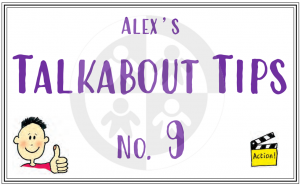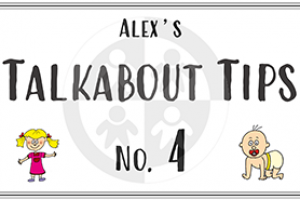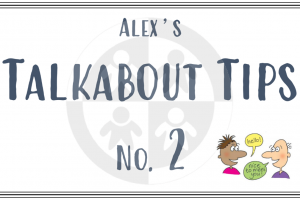What’s in this issue of Alex’s Talkabout Tips?
Happy New Year! Thank you for reading my first blog of the year. If you are anything like me, you will have made a couple of new year resolutions. I have given up telling other people (and myself) that I will improve my ‘work-life’ balance in 2022 as I know I will inevitably fail (again)! But I do love a new year, a new diary, a new beginning, and the opportunity to think about what this year might hold for me.
I also love a new project – so this may be the time to think about changing things in your place of work. Start a new intervention. Set up a new group. Get on top of those resources. Come up with a scheme of work to put Talkabout on to your curriculum… But where do you start?
This is one of the questions I get asked frequently. So I thought I would spend a few issues talking about it – how to get started in your school or your place of work.
I’m going to talk about your vision, assessing your students, and then planning your intervention. Some of these will need expanding on in future blogs, but hopefully this will give you the basics to get planning for the new year! So happy new year, and happy reading!
1 – A vision
 The first thing I tend to ask people is what do they want to achieve? Do you have a long-term vision for social skills work in your place of work? And if so, how can you get there? Some schools I work with want to go big and have a long-term plan to have Talkabout on the curriculum for all children. They may want all children to progress through the stages of Talkabout so that in the first year they do sessions on self-awareness and self-esteem, in the second year they cover body language, the third year, conversations, and so on. But they can’t get there immediately. And you need to understand some of the theory to understand this. So in working out your vision and how you will get there, it is important to know enough to get you started.
The first thing I tend to ask people is what do they want to achieve? Do you have a long-term vision for social skills work in your place of work? And if so, how can you get there? Some schools I work with want to go big and have a long-term plan to have Talkabout on the curriculum for all children. They may want all children to progress through the stages of Talkabout so that in the first year they do sessions on self-awareness and self-esteem, in the second year they cover body language, the third year, conversations, and so on. But they can’t get there immediately. And you need to understand some of the theory to understand this. So in working out your vision and how you will get there, it is important to know enough to get you started.
What’s the theory in a nutshell?
 The Talkabout programme was first developed in the early nineties following a clinical study into the effectiveness of social skills work which found that the success of work increased if nonverbal behaviours were taught prior to verbal behaviours, and assertiveness was taught last. In addition, we found that self and other awareness and self-esteem should be developed first if necessary and that friendship skills should be taught after social skills. If we spend time developing the foundation skills of self-esteem and self-awareness and then concentrate on body language prior to the more complex areas of conversational skills, friendship skills and assertiveness we are more likely to see progress.
The Talkabout programme was first developed in the early nineties following a clinical study into the effectiveness of social skills work which found that the success of work increased if nonverbal behaviours were taught prior to verbal behaviours, and assertiveness was taught last. In addition, we found that self and other awareness and self-esteem should be developed first if necessary and that friendship skills should be taught after social skills. If we spend time developing the foundation skills of self-esteem and self-awareness and then concentrate on body language prior to the more complex areas of conversational skills, friendship skills and assertiveness we are more likely to see progress.
So this is what I mean by the hierarchical method of intervention. It means that we develop skills ideally in the following order…
- Self-awareness & self-esteem
- Nonverbal behaviours (Body language & the way we talk)
- Verbal behaviours (Conversational skills)
- Friendship skills (Making & maintaining friendships)
- Assertiveness
This is important to know when setting out your vision for your school or place of work. You may want everyone to learn how to be assertive or to develop their friendship skills, but if those students don’t have the underpinning skills necessary to develop those more complex skills, then your vision is flawed, and you are in trouble.
Start small
 The other thing I tend to suggest is to start small, especially if you or your setting is new to this kind of work. You may have an amazing long-term vision but starting small can have huge benefits. It will build up your confidence in delivering this intervention. It will help others to see the impact this work can have. And if you assess and track the students’ progress, you can impress others with the work too. Which brings me onto number 2… assess to impress!
The other thing I tend to suggest is to start small, especially if you or your setting is new to this kind of work. You may have an amazing long-term vision but starting small can have huge benefits. It will build up your confidence in delivering this intervention. It will help others to see the impact this work can have. And if you assess and track the students’ progress, you can impress others with the work too. Which brings me onto number 2… assess to impress!
2 – Assess to impress
 As a clinician, I consider assessment to be an essential first step to working with someone. We must assess to know where to start. We must know where to start so that we set students up to succeed. And if we assess someone before we start working with them, we can then reassess at the end to evidence their progress. And I believe that we must do this to be taken seriously. My experience shows me that schools that have embraced an ‘assessment-reassessment’ culture are more likely to succeed in their ventures. Why? I think it’s simple… it’s because the ‘powers that be’, be it a head teacher, manager, or board of governors, love to see results. They tend to love a graph or a bar chart. So we need to get our heads around what needs to be assessed so that you can reassess it later and show results.
As a clinician, I consider assessment to be an essential first step to working with someone. We must assess to know where to start. We must know where to start so that we set students up to succeed. And if we assess someone before we start working with them, we can then reassess at the end to evidence their progress. And I believe that we must do this to be taken seriously. My experience shows me that schools that have embraced an ‘assessment-reassessment’ culture are more likely to succeed in their ventures. Why? I think it’s simple… it’s because the ‘powers that be’, be it a head teacher, manager, or board of governors, love to see results. They tend to love a graph or a bar chart. So we need to get our heads around what needs to be assessed so that you can reassess it later and show results.
There is quite a lot I could say about assessment, but I am going to summarise this into 2 points…
Assess self-awareness and self-esteem
 I would start by assessing someone’s self-awareness and self-esteem and I do this through a simple interview. Some of the Talkabout books have an interview in them, so check that out, if you can. But in short, we are trying to find out if the student struggles with their self-awareness and their self-esteem, because if they do, you need to start work here.
I would start by assessing someone’s self-awareness and self-esteem and I do this through a simple interview. Some of the Talkabout books have an interview in them, so check that out, if you can. But in short, we are trying to find out if the student struggles with their self-awareness and their self-esteem, because if they do, you need to start work here.
Assess social skills
 I would also do a baseline assessment of social skills to assess what strengths and needs a student has before you start any kind of work. There are different ways you can assess people, but if you want to be able to measure the effectiveness of what you do, you will need to choose an assessment that uses a rating scale. The Talkabout Assessment currently uses a 4-point rating scale but is being re-published this year with a 6-point scale, which will help track progress in more detail.
I would also do a baseline assessment of social skills to assess what strengths and needs a student has before you start any kind of work. There are different ways you can assess people, but if you want to be able to measure the effectiveness of what you do, you will need to choose an assessment that uses a rating scale. The Talkabout Assessment currently uses a 4-point rating scale but is being re-published this year with a 6-point scale, which will help track progress in more detail.
3 – Planning your intervention
![]() Having assessed your students, you will then undoubtedly want to start work. But I would like to suggest that you don’t jump straight in with a group / social story / role play… Step back and plan. And try my 4-step plan to intervention…
Having assessed your students, you will then undoubtedly want to start work. But I would like to suggest that you don’t jump straight in with a group / social story / role play… Step back and plan. And try my 4-step plan to intervention…
A 4-step plan to intervention
- Choose the skill… look at the assessment and choose the right place to start. Make sure you are setting the student up to succeed but considering the hierarchical model of intervention. So if they need self-awareness and self-esteem work – start here.
- Consider motivation… is the student motivated to work with you on the above? And what motivators are appropriate to use, if necessary. People will only change if they see the point, and ultimately want to.
- Look at the environment… is there anything that is occurring in their environment that is having an impact on their social skills / self-esteem? Does something need to change? Sometimes there are quick fixes in the environment that will have a positive impact on a student before you even start work with them.
- Choose the right strategy… now you can think about the intervention that will work best for your student. I enjoy developing skills in groups, but I also like to use other methods as well, such as role play and modelling, and problem solving, which will help with generalisation. The Talkabout books all have a specific focus – in the topic they teach and the client group they are aimed at – so check out the relevant book if you can to give you some ideas.
In summary…
I appreciate that this has been a bit of a ‘headlines in getting started’ blog and that all the above points need fleshing out. So, in the next issue I will look at the theory underpinning the social skills work in a bit more detail. And then we will tackle assessment.
In the meantime, you can read more about all of this in my book ‘Social Skills: developing effective interpersonal communication’(Kelly, 2019).
Please do comment on Facebook or share this with others. If you would like to be added to my email distribution list, please contact me through the website, email me directly or PM me.
Thanks for reading and here’s to a happy and healthy 2022!






